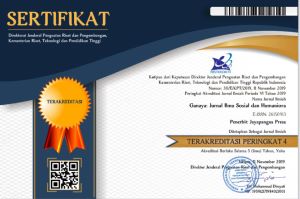Analisis Fraud Pentagon Terhadap Tindakan Kecurangan Laporan Keuangan Dengan Penggunaan Model Beneish
Keywords:
Pentagon Fraud, Fradulent, Beneish ModelAbstract
Fraudulent financial statements are a form of the category of fraud that often occurs. Another category of fraudulent financial statements is the category of fraud with the smallest frequency value, but will later result in a greater loss value than other categories. Pentagon fraud will be used in research, because this theory is a theory of refinement of triangles and diamonds. So that the pentagon fraud theory has a new element that is not present in both theories, namely arrogance which is not widely used in detecting fraudulent financial statements. The research objective is to provide information for shareholders, stakeholders, and other stakeholders about the pentagon fraud test against financial statement fraud using the Beneish Model detection tool in banking companies. The population in this study is all banking companies listed on the IDX in 2016-2018 totaling 43 companies. The sample in this study used purposive sampling, namely all banking subsectors listed on the IDX in 2016-2018 which consistently reported their finances. The data analysis technique used is multiple regression with the coefficient of determination, model feasibility test, partial test and logistic hypothesis test. Based on the research results, the variable of the effectiveness of supervision has no effect on fraudulent financial statements. The replacement of the chairman of the internal auditor has no effect on fraudulent financial statements. Financial stability has no effect on fraudulent financial statements. External pressure has no effect on fraudulent financial statements. Changes in company accounting policies have no effect on fraudulent financial statements.
References
Association of Certified Fraud Examiners (ACFE). (2012). Report to The Nation.
Association of Certified Fraud Examiners (ACFE). (2014). Report to The Nation.
Association of Certified Fraud Examiners (ACFE). (2018). Global Study on Occupational Fraud and Abuse. Report to The Nations.
Hall, J. A., & Singleton, T. 2007. Audit dan Assurance Teknologi Informasi (Edisi 2). Jakarta: Salemba Empat.
Hanifa, Septia Ismah dan Laksito, Heri. 2015. Pengaruh Fraud Indicators Terhadap Fraudulent Financial Statement : Studi Empiris Pada Perusahaan yang Listed di Bursa Efek Indonesia (BEI) Tahun 2008-2013. Diponegoro Journal of Accounting. 4, (4), 1-15.
Henny, Deliza dan Noval Dwi Aditya Nugraha, 2015. Pendeteksian Laporan Keuangan Melalui Faktor Resiko, Tekanan Dan Peluang (Berdasarkan Press Release OJK 2008-2012). E- Journal Akuntansi Trisakti, Vol. 2, No. 1: 29-48.
Ijudien, Didin. 2018. Pengaruh Stabilitas Keuangan, Kondisi Industri, dan Tekanan Eksternal Terhadap Kecurangan Laporan Keuangan. Jurnal Kajian Akuntansi, 2, (1), 82-97.
Kurnia, Aidil Adherian dan Anis, Idrianita. 2017. Analisis Fraud Pentagon Dalam Mendeteksi Kecurangan Laporan Keuangan dengan Menggunakan Model Fraud Score Model. Simposium Nasional Akuntansi XX. Jember.
Mahama, Muntari, 2015. Detecting Corporate Fraud And Financial Distress Using The Altman And Beneish Models: The Case Of Enron Corp. International Journal Of Economic, Commerce, And Management, Vol. 3, No.1: 1-18.
Marks, J. T. (2014). Playing Offense in A High-Risk Environment. Crowe Horwath, 1–16.
Martantya dan Daljono. 2013. Pendeteksian Kecurangan Laporan Keuangan Melalui Faktor Risiko Tekanan dan Peluang (Studi Kasus pada Perusahaan yang Mendapat Sanksi dari Bapepam Periode 2002-2006). Diponegoro Journal of Accounting. 2, (2). 1-12.
Rahardjo, Shiddiq Nur dan Kennedy Samuel Sihombing, 2014. Analisis Fraud Diamond Dalam Mendeteksi Financial Statement Fraud: Studi Empiris Pada Perusahaan Manufaktur yang Terdaftar Di Bursa Efek Indonesia (BEI) Tahun 2010-2012. Diponegoro Journal Of Accounting, Vol. 03, No. 02: 1-12
Rini, V. Y. 2012. Analisis Prediksi Potensi Risiko Fraudulent Financial Statement Melalui Fraud Score Model (Studi Empiris pada Perusahaan Manufakturyang Terdaftar di Bursa Efek Indonesia Tahun 2008-2010). Skripsi. FEB, Universitas Diponegoro Semarang.
Sari, Maylia Pramono dan Sukirman, 2013. Model Deteksi Kecurangan Berbasis Fraud Triangle (Studi Kasus Pada Perusahaan Publik Di Indonesia). Jurnal Akuntansi & Auditing, Vol. 9, No. 2: 199-225.
Siddiq, Faiz Rahman., Achyani, Fatchan., dan Zulfikar. 2017. Fraud Pentagon Dalam Mendeteksi Financial Statement Fraud. Seminar Nasional dan The 4th Call For Syariah Paper.
Simon, Jon, Ahmar Khair A.H., and Mohamed Yusof K, 2015. Fraudulent Financial Reporting: An Application Of Fraud Models To Malaysian Public Listed Companies. The Macrotheme Review: A Multidisciplinary Journal Of Global Macro Trends, Vol. 4, No. 3: 126-145.
Ulfah, Maria., Nuraina, Elva., dan Wijaya, Anggita Langgeng. 2017. Pengaruh Fraud Pentagon dalam Mendeteksi Fraudulent Financial Reporting (Studi Empiris Pada Perbankan di Indonesia yang Terdaftar di BEI). FIPA. Vol. 5. No. 1. Oktober 2017. Hal : 399-418.
Wicaksono, Gregorius Satrio. 2015. Mekanisme Corporate Governance dan Kemungkinan Kecurangan dalam Pelaporan Keuangan. Skripsi. FEB, Universitas Diponegoro Semarang.
Wolfe, D. T., & Hermanson, D. R. (2004). The Fraud Diamond: Considering the Four Elements of Fraud. CPA Journal, 74(12), 38–42.
Downloads
Published
How to Cite
Issue
Section
License
An author who publishes in the Ganaya : Jurnal Ilmu Sosial dan Humaniora agrees to the following terms:
- Author retains the copyright and grants the journal the right of first publication of the work simultaneously licensed under the Creative Commons Attribution-ShareAlike 4.0 License that allows others to share the work with an acknowledgement of the work's authorship and initial publication in this journal
- Author is able to enter into separate, additional contractual arrangements for the non-exclusive distribution of the journal's published version of the work (e.g., post it to an institutional repository or publish it in a book) with the acknowledgement of its initial publication in this journal.
- Author is permitted and encouraged to post his/her work online (e.g., in institutional repositories or on their website) prior to and during the submission process, as it can lead to productive exchanges, as well as earlier and greater citation of the published work (See The Effect of Open Access).
Read more about the Creative Commons Attribution-ShareAlike 4.0 Licence here: https://creativecommons.org/licenses/by-sa/4.0/.








